Back in the day -- cooking with your college roommates
Freiburg, Dec 07, 2017
It can be a challenge even for a professional chef: Hans-Albert Stechl, cookbook author and Badische Zeitung columnist for “Stechls Standgericht” (“Stechl’s Court(ly) Order”) prepares a three-course Christmas meal for two people on a two-burner electric stove. All the ingredients cannot cost more than 20 euros. A photo documentary shows how well the lawyer, chairman of the SWR administrative board and alumnus from the University of Freiburg did – under conditions that he most likely hasn’t experienced since college.

Photos: Klaus Polkowski
“Every single recipe in this world begins like this: You take a glass of the best wine in the world and pour it down the chef’s throat,” says Hans-Albert Stechl as he reaches for the University wine, a pinot noir from 2016. He then whips out his tools: a wooden cutting board, two sharp all-purpose knives, a spatula, a cooking spoon. “I don’t need more than that.” Positioned on a tiny square table in the kitchen from the Freiburg Institute for Advanced Studies (FRIAS), the ingredients stand at the ready. Time to get started.
Appetizer: French toast with a mushroom ragout
“A lot of people like to eat dumplings with mushrooms, but then fail. This dish tastes exactly the same, but it’s easier to make,” the cook explains, describing his selection.
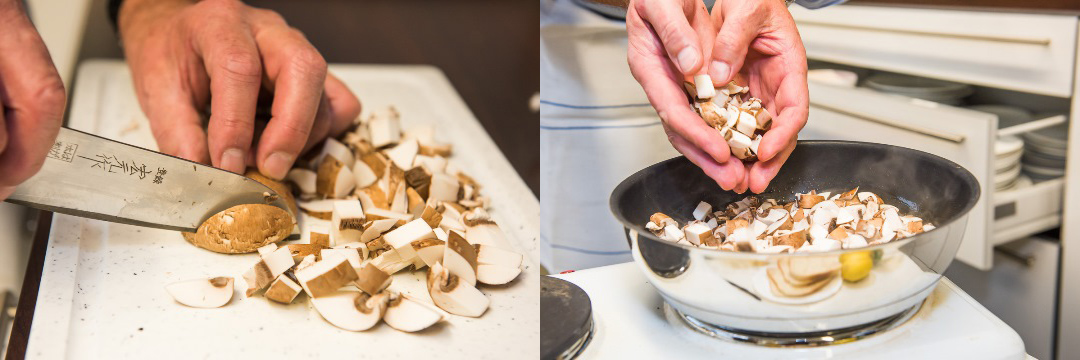
First thing: slicing and dicing. Shallots and garlic “in tiny bits, no whoppers allowed.” Then the mushrooms cut twice down the middle, twice down the side. Stechl tosses a pad of butter into the pan and turns on the two-burner electric stove, which he views skeptically. “It’s gonna take a while for it to warm up. Lordy.” Privately, he cooks with a gas stove. But after just a few minutes, a mild onion fragrance wafts throughout the kitchen. Because the shallots should only be glazed, Stechl has to remove the pan from the stove and grabs the next one. Now it’s the mushrooms’ turn, but with oil. “You have to brown them at a higher temperature, but that doesn’t jive well with butter.” He stirs the mushrooms as he becomes more familiar with the stove. “Once the burner gets going, it works well.”

As the mushrooms start to sizzle, Stechl cracks open an egg into a bowl with one hand, scrambles it with a whisk and dumps a piece of toast into the mixture. He then mixes the mushrooms with the shallots, cleans out the pan that is now available and melts butter in it “because it tastes better together with the egg.”
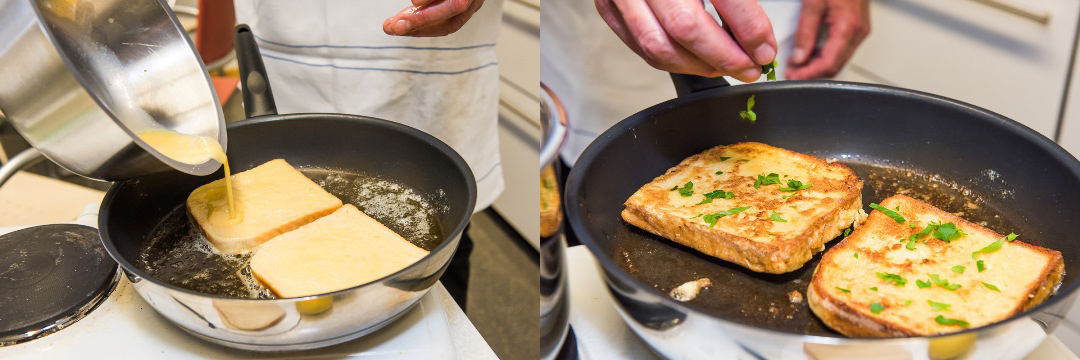
Next he places the bread in the pan and pours the rest of the egg over it. After a few minutes he lifts a slice up to look underneath: not brown enough. “The stove is a little lame indeed,” he complains, but whistles happily as he picks at the parsley, garnishes the bread and flips the slices. “So, my dear pan, let’s do it.”
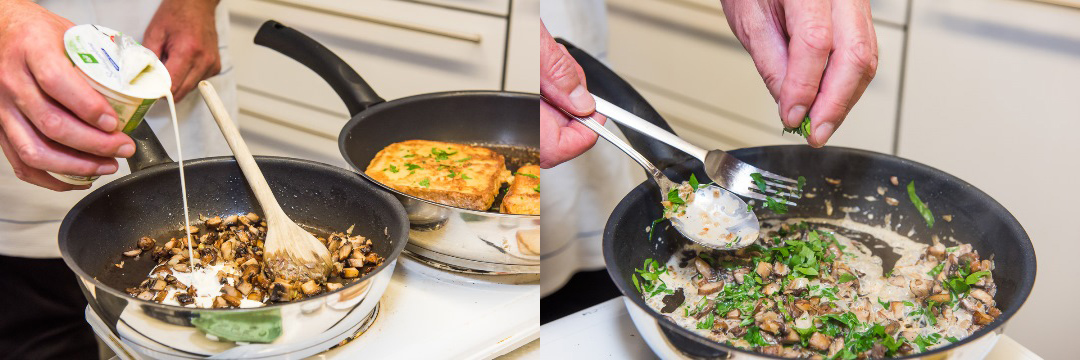
Mushrooms and shallots have cooled off in the meantime. A quick jaunt to the second burner with them, “and then a huge portion of parsley and some cream”. Et violà! The ragout is done.
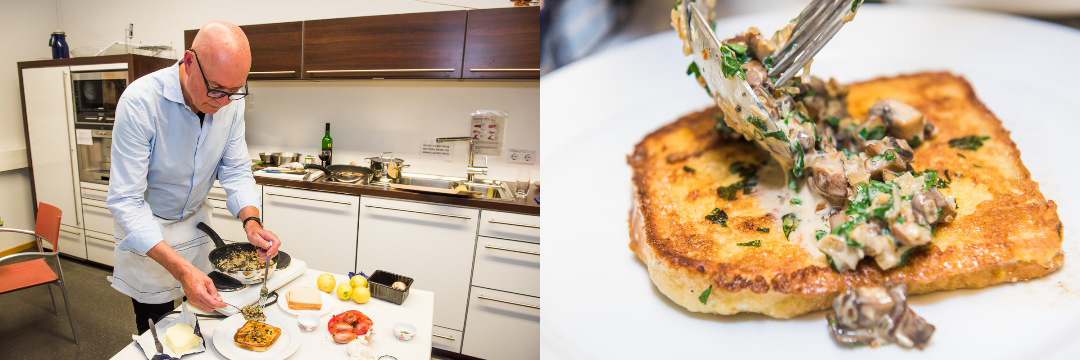
“Give me the plate, it’s almost time,” Stechl announces merrily, places the nicely fried bread slices onto the plate, grabs a fork and spoon and drips ragout elegantly across it. Preparation time: 25 minutes.
Main course: Vegetable couscous with fried duck breast
“A foolproof recipe,” comments the cook. “You just can’t let anything burn. And couscous fills hungry tummies.”
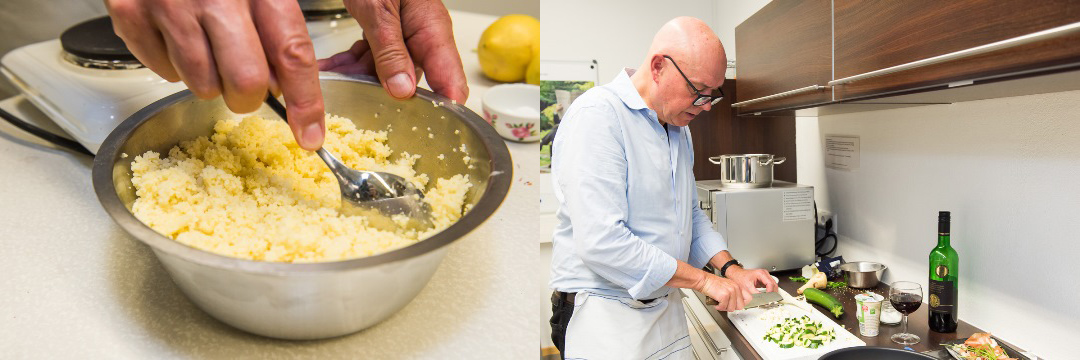
A minor misstep at the beginning: The couscous package rips open farther than planned. Stechl expertly captures the errant kernels with a bowl and pours one and a half times the amount of hot water over them. Chopping is on the agenda once again and it turns out that the cook likes diced vegetables. Zucchini, parsnips, carrots. “But you can use any kind of vegetable. It always tastes delicious.”

Stechl turns his attention to the duck breast. With a sharp all-purpose knife – “bought for about 10 euros in Japan. It’s good for almost anything. You don’t have to pay 200 euros for something like this”. He punctures the skin of the meat from the top, salts both sides and places it in the pan. This time he uses neither butter nor oil. “If you place the duck breast on its side, enough fat will come pouring out of it.” A thin film has already started to form beneath the meat. In the second pan, he tosses in a pad of butter. “It’ll be seared in it for a bit.” First the parsnips and carrots because they take longer, then later the zucchini. Then a bit of salt and pepper. Both pans are hissing nicely.
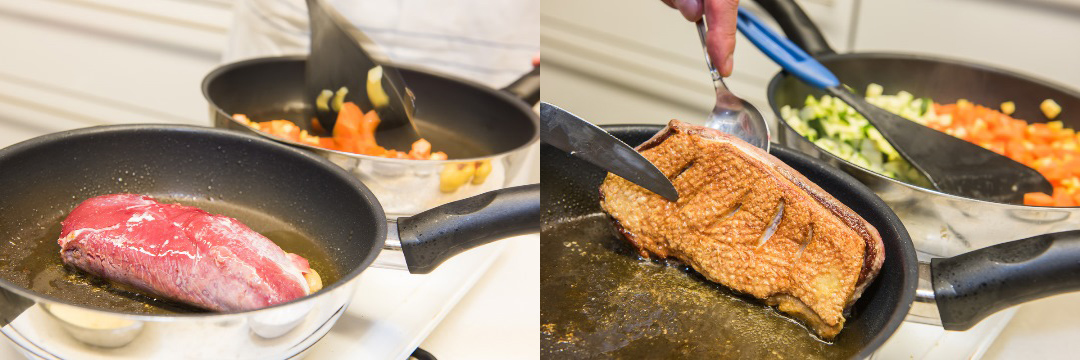
After 10 minutes the skin of the duck breast has become crisp. Stechl turns the meat over. “Now another seven or eight minutes. If we had an oven, I would have let it rest there for another 10 minutes at 80 degrees Celsius.” But no go. The two-burner stove has to suffice. So the cook lets the duck breast rest a tad in the warm pan after he has taken it off the stove.

Back to the side dishes: Stechl stirs a pad of butter underneath the couscous and adds it to the vegetables in the pan. Then he cuts a lemon in two, squeezes the juice over it and mixes everything with a wooden spoon and spatula. “Actually, I would prefer a shot of olive oil as a dressing as that would accentuate the flavor even more.” But unfortunately, that wouldn’t fit his budget.
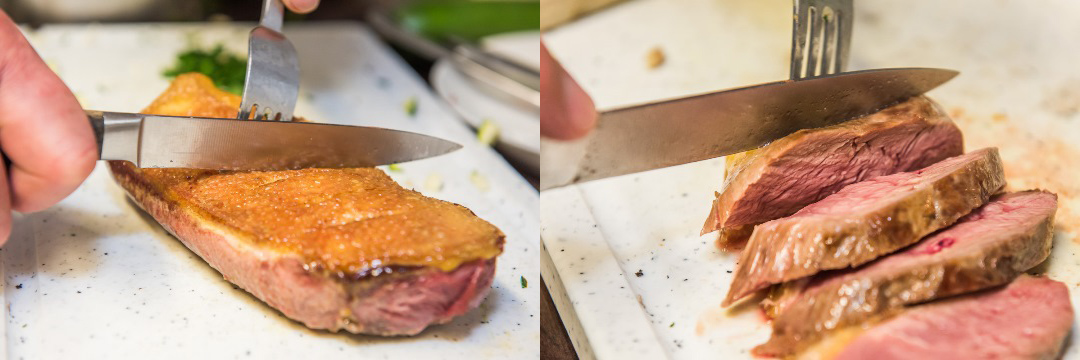
“I have no idea if it’s ready,” admits Stechl a few minutes later, looking with anticipation at the duck breast as he slices it. “Almost a bit too raw,” is the diagnosis. Another few minutes in the pan and then it is as light pink as the cook likes it to be.

Stechl serves the vegetable couscous onto the plates and places the meat slices next to it. “A bit of pepper on top, shoobidoo, and then the parsley as that makes it look fresh”. After all, it should be a feast for the eyes as well. Preparation time: 45 minutes.
Dessert: Crêpes Suzette
And once again butter is needed for frying. The motto: “A few more calories won’t matter.”
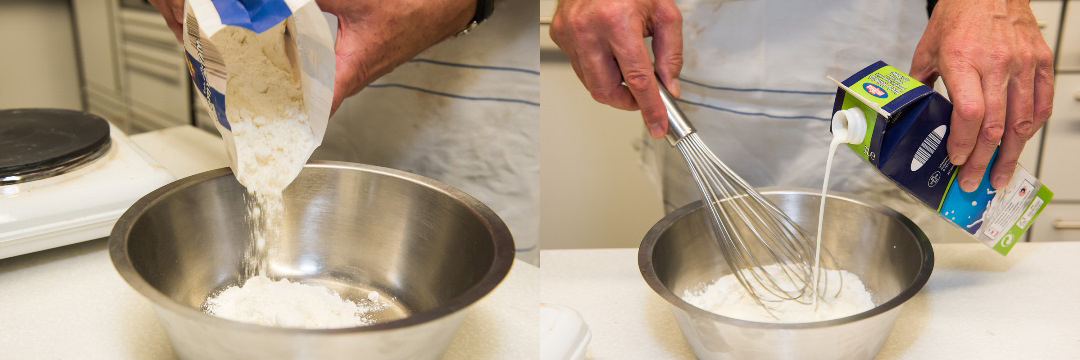
Kitchen scale? Don’t have it. Just his own visual sense of proportion. Stechl dumps flours into a bowl and slows whisks in the milk. Vanilla sugar and egg follow. The liquid dough turns yellow.

“Now the orange is going to be disjointed,” announces Stechl and whistles a happy tune. “It requires advanced carving.” He peels the piece of fruit with the knife in order to remove the white interior layer at the same time. He then cuts out the filets. “It’s not that difficult,” he admits. “You just have to cut between the peel and the pith. Then it looks nice.” The filets are placed in the bowl and the rest of the fruit gets a good squeeze for its juice. “You can only do it with manually if you haven’t touched any garlic beforehand.”

Stechl heats up both burners. In one pan he places a pad of butter, in the other he pours in sugar. “Hopefully it will be hot enough for the sugar to caramelize,” he says skeptically. A bit later he has reason to be happy. “It’s melting, it’s melting!” he shouts, pointing to the pan. “But it’s a thin line. The sugar should be brown, but not black.” Stechl plays it safe and deglazes it with orange juice. Steam swirls through the air. In go the orange fillets so that they can caramelize as well. The second part of the dough goes into the second pan.

Stechl isn’t quite satisfied. “The butter has gotten too brown. The crêpe has then too.” For the next crêpe he doesn’t let the pan get as hot and then a large flip – a sudden movement and the crêpe goes flying through the air, flips in mid-flight and lands precisely back into the pan. Stechl slaps the finished crêpes onto a plate, folding them into quarters. He places the orange filets onto them with a spoon and then drizzles the caramel butter directly from the pan on top. “A bit thick, exactly as it should be.” Preparation time: 20 minutes.

The challenge has been met: Within 90 minutes three courses have to sit on the table. Simple ingredients, simple recipes – and that with a two-burner stove. “People, don't stress out.” That’s Stechls most important advice for a successful Christmas meal. “Otherwise you won’t enjoy any of it.”
Nicolas Scherger
Hans-Albert Stechl’s Christmas menu
Appetizer: French toast with a mushroom ragout
2 slices of toast
2 eggs
2 shallots
1 cloves of garlic
1 bunch of flat leaf parsley
1 cup of heavy cream
250 grams mushrooms
salt, pepper
butter and oil for frying
Peal the shallots and garlic, dice them finely and steam with butter in a pan at a mild temperature until golden brown. Remove them from the pan onto a plate and set aside. Wipe out the pan with a paper towel, add oil to the pan and fry the mushrooms until seared. Turn down the heat, add the steamed shallots and garlic to the mushrooms, add heavy cream, salt, pepper, mix and keep warm in the pan.
Whisk eggs, add salt, places (untoasted!) toast bread into it so that it absorbs the liquid well. Melt butter in the second pan, bake the bread slices on both sides in the pan until golden brown.
Pick a few parsley sprigs and finely chop them.
Place a slice of bread onto each plate. Add parsley to the mushrooms, reheat and serve the mushroom ragout onto each slice of bread. Sprinkle the rest of the parsley over it. Add pepper.
Main course: Vegetable couscous with fried duck breast
250 grams of couscous
500 grams of mixed vegetables (such as zucchini, carrots, leeks, parsnip, parsley root)
1 lemon
parsley
1 fresh duck breast
salt, pepper
oil for frying
Dump couscous into a bowl and pour hot water over it according to the package’s instructions. Let it soak.
Wash the vegetables, finely dice them and fry them to a crisp in a pan with butter.
Puncture the duck breast’s skin several times, salt the duck breast on all sides and, without any fat, vigorously fry it in a pan, first on the skin side, then on the other for eight minutes each. Remove the pan from the burner and allow the duck breast to rest in a warm pan for another five minutes – wrapped in aluminum foil if possible.
Add the couscous to the vegetable pan, season with salt, pepper and lemon juice, heat it altogether, add the finely chopped parsley.
Cut the duck breast into 1.5 cm slices. Place the couscous on the plate along with the duck breast slices and add pepper. If available, drizzle fresh olive oil on top.
Dessert: Crêpes Suzette
2 eggs
100 grams of flour
¼ liter milk
1 packet of vanilla sugar
100 grams of sugar
1 large orange
butter for frying
Combine flour, eggs, milk and vanilla sugar to a rather liquid-like dough. Let the dough steep for 10 minutes.
Cut off both tips of the orange with a sharp knife. Place the orange on the bottom end, cut the entire peel in strips around the orange so that the pulp is visible and the fine white pith has been removed. Take the orange in your hand and place over a bowl (to capture the juice) while separating the individual segments. Put the orange fillets to one side. Squeeze the rest of the orange with your hand into the bowl.
Pour sugar into a pan and distribute it evenly until it is light brown. Be careful that it doesn’t get too dark. Then immediately deglaze it with orange juice. Place the orange filets into it so that they get warm and absorb the caramel flavor.
Stir the dough once again. Heat butter in the second pan, pour half the dough into it, tilting the pan so it is evenly distributed in the pan and cook the pancakes (crêpes) to a thin, golden brown hue on either side.
Fold the crêpes into quarters, place on the plates along with the orange filets and drizzle the orange caramel on top.
Kitchen gadgets
2 pans
1 cooking pot
1 cooking spoon
1 spatula
2 mixing bowls
1 whisk
1 cutting board
Knives and vegetable peeler

